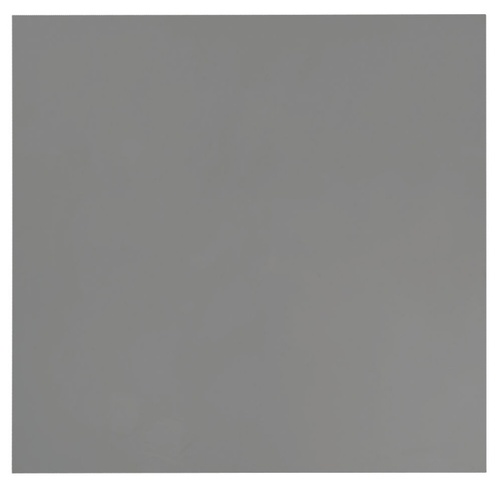
Henry Codax, Untitled (Dark Grey), 2011, via christies.com
Wow, do I owe Henry Codax an apology.
Last week I’d declared the fictitious painter’s beautiful gray monochrome a failure because, not only did it not “Strip away any obvious authorship,” the Christie’s catalogue text for the painting laid authorship down in thick coats by stating as fact that Codax was “a pseudonym created by New York-based artist Jacob Kassay and the Swiss conceptual artist Olivier Mosset.”
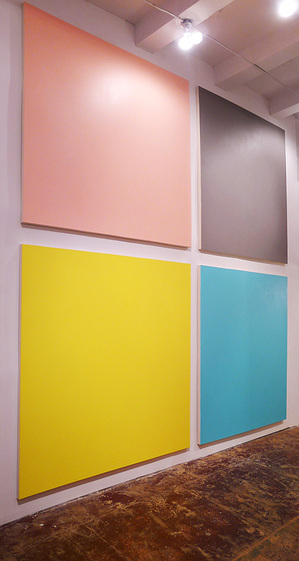
installation shot, Henry Codax paintings, Carriage Trade, June 2011
I’d been surprised to see the attribution laid out so definitively, especially after re-reading the source of that attribution, Andrew Russeth’s Gallerist NY article on the Codax show last summer at Carriage Trade. Russeth did indeed report that “a source”–who he did not characterize in any way–had told him about the Mosset/Kassay collaboration, but Carriage Trade would not comment on Codax’s origins–and still won’t, btw–and both real-life painters’ galleries stated they had no idea about the work or the project.

Olivier Mosset paintings installed with bikes by Jeffrey Schad and Vincent Szarek, 2011, Christopher Grimes Gallery, Santa Monica
In the Wikipedia age, though, where truth is trumped by verifiability, Russeth’s article was proof enough for the paintings to find buyers. And for at least one buyer, who apparently figured they’d cash in on the recent Kassay mania by flipping the dark grey monochrome at auction. And for Christie’s, who ignored the work’s similarities to the venerated-but-less-marketable Mosset’s work to assert that “In the present example, Kassay’s iconic silvery paintings have been replaced by a sleek, anonymous grey surface.”
Yes, well. Actually, no.
At Christie’s First Open sale last Wednesday morning, the Codax had been bought in, which means it didn’t sell, either because bidding didn’t reach the reserve price, or because there was no bidding at all. At first, I’d figured the work wasn’t Kassayish enough after all, or that its conceptual conceits were too cute for the speculators in the market.
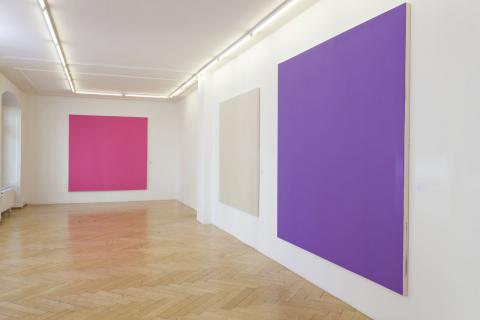
Henry Codax and Stephane Kropf at Susanna Kulli Gallery, Zurich, Oct. 2011
But then someone who attended the sale told me that Christie’s had read a statement, known as a saleroom note, before bidding began, in which Kassay said he’d “had nothing to do with” the painting, and that his “name should not be associated with it.” [In trying to confirm the text of the actual statement, I contacted Christie’s, first as press, and then finally as client. The specialist who worked on the lot was helpful, if circumspect. But she also referred me to the sale results page, which, I was told, would have the saleroom notice appended. Except, of course, it didn’t, because Christie’s deletes online references to unsold lots completely, in order to not taint their saleability in the future.]
Whatever was said was apparently enough to dissipate the Kassay cachet. [Christie’s did not receive a similar demand from Mosset.] But more importantly, or more interestingly, it also reopened the speculative possibilities surrounding Codax’s work and who might have made it. And how it closes and generates gaps between an object and the projections upon it.
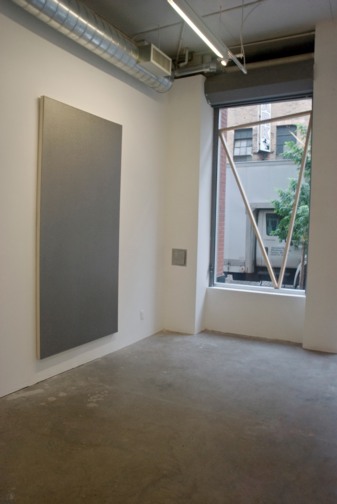
Olivier Mosset work in 1107 Manhattan Ave, a group show at Spencer Brownstone, which also included works by studio neighbor Kassay, Sept. 2011
The real [fictional] Codax, the character in Bernadette Corporation’s collectively authored novel Reena Spaulings, was known for “expensive, impressive monochromes.” Yet these were neither, and after failing to sell at auction, they were even less so. Reviewing the show for Frieze, Piper Marshall noted the authorship issue’s resonance with Mosset’s earliest practice, when, as BMPT, he and three fellow painters, Daniel Buren, Michel Parmentier, and Niele Toroni, would make and sign each others’ work.
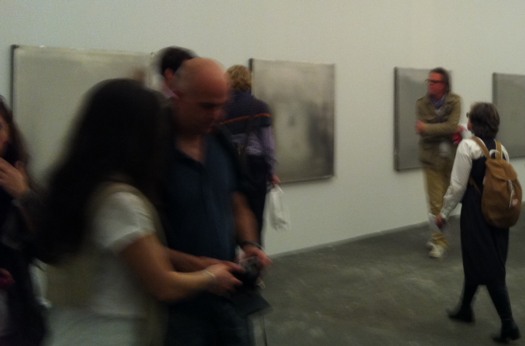
Jacob Kassay installation, eight square, silvered paintings at Art Basel, June 2011, image via gallerist ny
But once Gallerist published their persuasively well-informed speculation, these large, uniform, anonymous paintings suddenly became a roomful of *wink* Kassays, which, unlike the roomful of square Kassays just shown at Basel, were available to buy. Even if you weren’t “a real museum.” And at up to 95% off. As long as you didn’t mind the uncertainty. And as long as you were happy with an unsigned painting accompanied by a certificate authenticating the work only as by “Henry Codax.” And if the work is ever captured by the market, the artists will deny all knowledge of its existence.
Our capitalist culture is based upon the premise that corporations are people, too, and legal disputes are regularly resolved by exchanges that include “no admission of wrongdoing.” With a political system where plausible deniability is S.O.P. and legal motions are made that “neither confirm nor deny” their subjects. It does makes one wonder why the art market can’t accommodate a painting by a fictitious artist derived from a collectively written novel by a fictitious gallerist published by a corporation, even without the unconfirmed involvements of two well-known, living artists.
So Henry Codax, I sincerely apologize, and I salute you, for you are truly an artist of our time. C-A-L-L M-E.
Leonardo Photomural
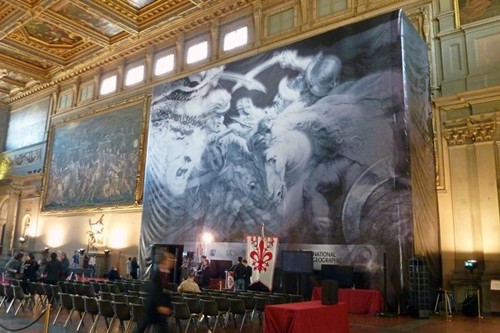
image: DARIO THUBURN – AFP/GETTY IMAGES, see washpost for fullsize
There has been much talk among such circles about the possibility of a lost, unfinished mural by Leonardo da Vinci hidden behind a fresco by Giorgio Vasari, in the Palazzo Vecchio in Florence.
Leonardo’s original work, The Battle of Anghiari, executed in 1504, was replaced in 1564 by Vasari’s 5-fresco cycle. But art historians following an interpretation of a clue in one mural discovered it was painted on a false brick wall, and there was an airspace behind it.
And now there is also paint. National Geographic, which purchased the exclusive first rights to the controversial investigation, today announced the discovery of Leonardo-era pigments in the hidden airspace.
The press conference was held in front of the mural[s], which were covered by a giant, digitally printed photomural, actually a detail of a Rubens drawing of the Leonardo original.
If there is, in fact, a Leonardo back there, which has been hidden, or even lost, for nearly 500 years, I honestly don’t see the hurry to uncover it now. Critics of the project are right to protest the possible damage or destruction of the Vasari the search–or worse, the discovery–may inflict. But if we have, in just the last few years, developed the tools to detect the space and the Leonardo, isn’t it best to sit tight, and wait for technology that can preserve both artworks intact?
At least just wait like a hundred years or so, for the current crop of Da Vinci Code knuckleheads to die off. And in the mean time, why not just put up a giant photomural version of Rubens’ copy? 99.9% of the 8 million visitors who’d see it each year wouldn’t mind–or even notice.
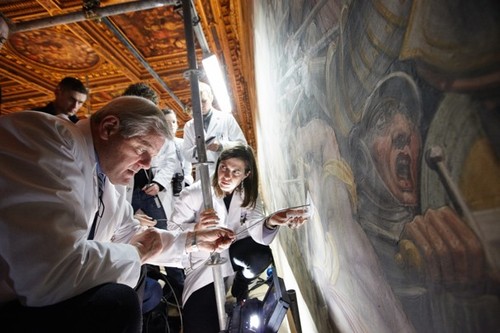
Sen. John Kerry and team use a probe to look for what they believe may be Leonardo’s Battle of Anghiari behind a fresco at Florence’s town hall. Photograph: Dave Yoder/AFP/Getty Images
Art historians say they have found evidence of ‘hidden’ Leonardo da Vinci [guardian via galbraith’s twitter]
Google Street View, Wide-Eyed
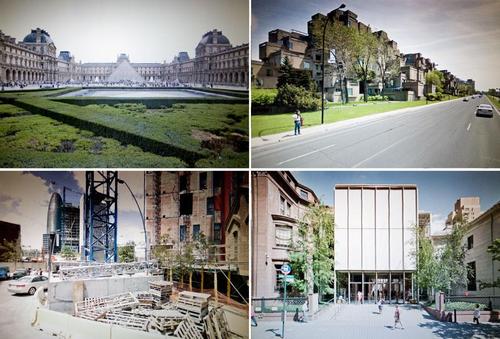
Jon Rafman’s got his 9 Eyes, but maybe what we really need is a 5 Stages of Google Street View, something to account for the process by which people awaken to the aesthetic, social, conceptual, and ultimately, political implications of Google’s worldmapping project.
Urban architecture photographer Andrea Bosio has passed Stage 1: Looking up your own house on GSV, and has managed to turn Stage 2: Visiting famous places–in his case, name brand architecture–into a photo essay for Domus:
I have always used Google’s Satellite and Street View system to view cities and principally to identify the urban drift areas featured in some of my photographic projects. In these cases, I use software as if it were a map made of pictures to find my way through the reality at times of direct experience. This is also the approach I adopted for the photographic project presented here although, on this occasion, the subject of my shots was the representation of the city supplied by Google Street View on my computer screen. I treated this new pixelated reality as a territory up for exploration and managed to compile a true photographic record of it by selecting different points of observation in this virtual space. I photographed the city without ever actually being there.
Which, shooting screens, hmm. Also: “We are able to experience the reality in an objective and non-interpretative portrayal.” Which, hmm.
At least Bosio demonstrates the potential of GSV for creating postcard views.
I’ve never been there, by Andrea Bosio [domusweb.it]
Here Is A Giant, Awesome NASA Test Chamber From Fashioning Apollo
John Powers has been on me for months to read “>Nicholas de Monchaux’s Fashioning Apollo, the incredible and unlikely history of the development of the Apollo spacesuits.
And I have been meaning to, I swear, but this insane photo may be just the thing to push me over the edge. Because in his otherwise heady interview with de Monchaux, Geoff Manaugh only captions the images as being from the book.
Which I will have to buy, to find out what this three-story dolly was doing in this massive, origami-ended space lined with sound-deadening foam pyramids. Because seriously, holy smokes.
Spacesuit Interview with Nicholas de Monchaux [bldgblog]
Star Wars: The Topher Grace Edit
As part of his study of the art of editing, and to do good for all mankind, the actor Topher Grace recut Star Wars episodes 1-3 into an 85-minute prequel which focuses on the transformation of Anakin into Darth Vader. Paul Sciretta attended a secretive screening of the Grace Edit, and prepared a detailed write-up for Slashfilm. Given what Grace had to work with, the remix sounds pretty good. But then there’s this:
Before the film screened a trailer for another film Topher Grace is remixing — Steven Spielberg’s Close Encounters of a Third Kind. I’m not sure that film needs a remix, or could even benefit from a remix, but am interested to see what the experiment will look like. After that, Grace hopes that other actors, editors and filmmakers will run with the ball, produce and showcase remixed films on a annual basis within this private community.
Jason Reitman has been directing live stage reads of classic film screenplays at LACMA, showing how a filmmaker can make different choices with an interesting cast can completely change a written screenplay. This seems like the next evolution of that, but also an exercise in storytelling with the use of crafty editing. I’m not sure I completely understand Grace’s motives in creating this film, but I enjoyed it regardless.
Close Encounters has already gone through several notable edits, as Spielberg tinkered with it. [The director himself considers the 2001 Collector’s Edition to be the definitive version.]
I’m kind of fascinated with this idea of using commercial films and their inputs as raw material, and especially with seeing people inside the Hollywood bubble, who are likely to be indulged rather than sued, softening up the crowd. I may get around to making my shot-for-shot remake of Gus Van Sant’s Gerry yet.
Topher Grace Edited The ‘Star Wars’ Prequels Into One 85-Minute Movie and We Saw It [slashfilm via umm,
Michael Riedel Photomural
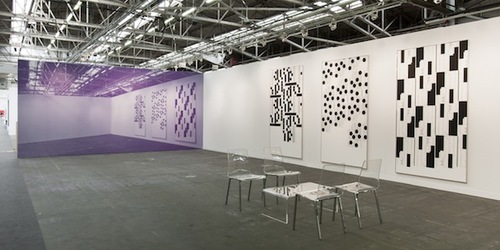
[image via artinfo]
A little Anastasi, a little Lawler, a little Shore, a little Fischer, a little Albenda. I wonder what color Michael Riedel’s awesome photomural in Zwirner’s booth will be by the time I get to the Armory show?
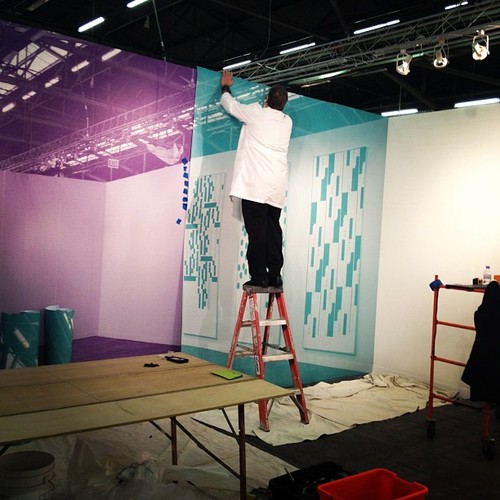
[image via @artnet]
Ladies Love The Mylar
This is fantastic, a 1955 industrial film by E.I. duPont deNemours, Inc. about their miraculous new plastic film, Mylar.
I mean, first off, it’s Mylar, so satelloons and Warhol balloons and everything else about the future.
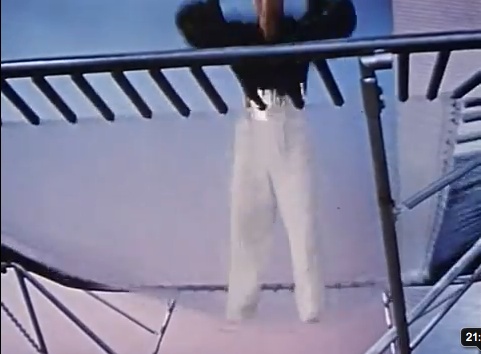
But then there’s the film itself. The Mylar trampoline and trapeze–with acrobats. The circus-y knifethrower’s assistant in satin hotpants and beret, doing her ur-Vanna Whitest by turning the painted bullet point signs around.
Henry Codax At Auction

Jacob Kassay can’t hide. One of the square monochromes he allegedly1 created allegedly2 with Olivier Mosset for last summer’s Henry Codax show at Carriage Trade is being flipped this week at Christie’s.
Fortunately [sic], it’s the awesomest, i.e., most Richterian-looking, one: Untitled (Dark Grey). I love the lot description too much not to quote it in full:
Henry Codax, a pseudonym created by New York-based artist Jacob Kassay and the Swiss conceptual artist Olivier Mosset, is referenced from a fictional character in the contemporary novel Reena Spaulings published in 2005. Co-authored by the collective Bernadette Corporation, an international conglomerate of artists, critics, dealers, and performers, Codax is described in the novel as a painter that [sic] “devotes his practice to a steady production of expensive, intimidating monochromes.” In the present example, Kassay’s iconic silvery paintings have been replaced by a sleek, anonymous grey surface. Stripping away any obvious authorship, Kassay and Mosset’s Henry Codax joins the company of fictional and psuedonymous artists including Marcel Duchamp’s Rrose Selavy and Richard Prince’s John Dogg.
With a beefy credit line like that, the one thing this work fails at is the stripping away of authorship. And with an estimate of just $10-15,000, Codax is still quite a ways away from expensive. But it’s early.
1 & 2 UPDATE: I can’t imagine that it was designed to, but this Codax Moment turns out to be a crisp snapshot of how rumor becomes reporting, which then calcifies into bankable fact.
Between the time I read Andrew Russeth’s story last year of rumors about Kassay’s and Mosset’s involvement in Henry Codax’s art and this auction, I’d already forgotten that neither artist nor any gallery involved with them or the show had ever commented on or claimed authorship. In fact, the artists’ reps said they knew nothing about it. Andrew even wrote of Kassay’s possible involvement, “Of course, that is all speculation: with no one stepping up to claim authorship of the works, it is impossible to say.”
And yet less than a year later, here is Christie’s, describing both artists’ participation as fact, and selling the painting on that basis. And I, too, basically said, “Sure, that’s how I remember it, I guess.” Except that Christie’s goes even further by linking this gray canvas directly to the shiny auction hotness of Kassay’s silvered paintings. Even though the only real similarity is the color range.
And though the format’s a bit different, if Codax’s work looks like anything, it’s Mosset’s conceptual monochromes. Of course, Mossets are not as frenzied a commodity as Kassays are, so that evidence/resonance, not furthering Christies’ purposes, goes unmentioned. And again, unclaimed and uncommented upon by the artist.
If there’s a question of whether the hyper-speculative Kassay auction market had the theoretical chops to handle the authorial ambiguity associated with Codax’s work, they were dispelled last week, when the painting failed to sell.
UPDATE 3: And failed to sell in a very fascinating way. Kassay insisted that Christie’s read a statement disassociating his name from Codax’s work, which restored the ambiguity surrounding the fictional painter’s factual progenitors to a nice sheen.
Mar 7, 2012, Lot 69: Henry Codax, Untitled (Dark Grey), 84x84in, est. $10-15,000 [christies]
Previously:on Jacob Kassay and collaboration
Related: Piper Marshall’s review of Henry Codax’s Carriage Trade show for Frieze [frieze]
Robert Montgomery: Spectacular Vernacular
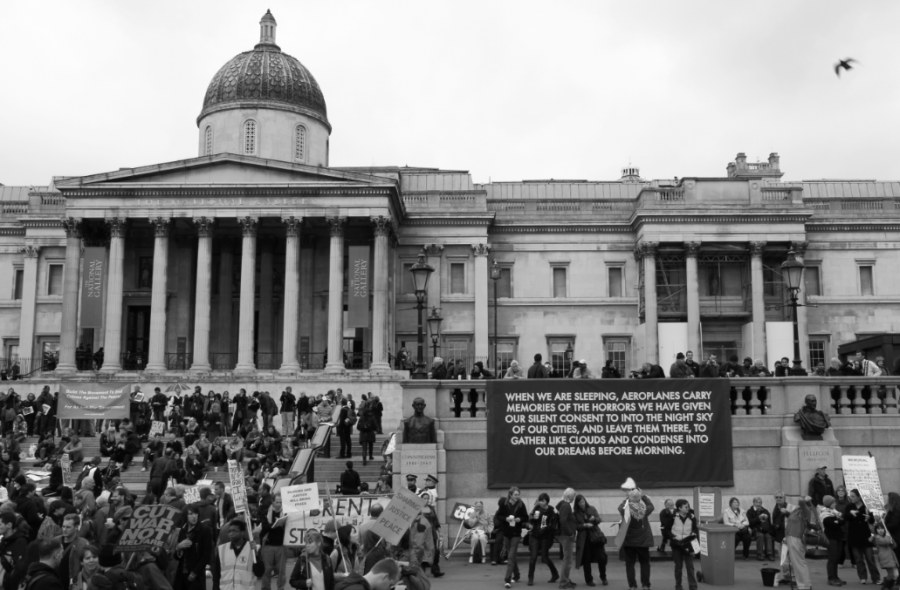
I’ve got a few reservations, but I’m really quite smitten with London-based Scottish artist Robert Montgomery’s poetically critical billboard artworks.
The one above was unfurled at a Stop The War protest in Trafalgar Square last October. It reads:
WHEN WE ARE SLEEPING, AEROPLANES CARRY
MEMORIES OF THE HORRORS WE HAVE GIVEN
OUR SILENT CONSENT TO INTO THE NIGHT SKY
OF OUR CITIES, AND LEAVE THEM THERE, TO
GATHER LIKE CLOUDS AND CONDENSE INTO
OUR DREAMS BEFORE MORNING.
If the stark white-on-black text and the clouds and the protest didn’t already remind me of Felix Gonzalez-Torres, this particular photo, which ran on Purple’s blog, even has a bird in flight in the upper right corner.
Montgomery’s standard M.O. is to paste his billboards guerrilla-style, without permission, on top of existing advertisements. But for
an exhibition last month at KK Outlet, the gallery got authorization to install a series of three billboards with something of an Occupy theme. [Occupy had been occupying nearby at Shoreditch, and the artist had a collaborative project planned, but, as he told the Independent, “they got turfed out on 25 January so that didn’t happen.”]
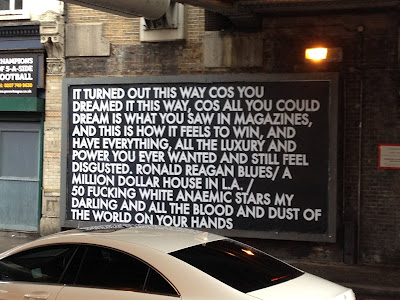
The deployment of poetry as protest takes its cue, Montgomery readily acknowledges, from the Situationists and Guy Debord, which, baby and bathwater and all, I will accept. My ambivalence, such as it is, really has more to do with Montgomery’s apparent activism on the fashionista front, his day jobs at Dazed and Confused, his carousing with Olivier Zahm, even the galleries that tout their Occupy shows one month, and their design studios working for LVMH the next.
But who’s to complain, seeing as how I followed the linkstream to his work while surfing for extraordinary calf leather shoes myself?
Let he who is without consumerist sin throw the first stone. Is being the global street fashion industrial complex’s social conscience is any more damning than being the art world’s anything?
Montgomery’s disarming, enticing, depressing, enlightening poems are still there, still catching advertising-conditioned passersby, only to release them with an unsettling thought in their heads.
Givin’ me 500 Errors right now, though: Robert Montgomery portfolio site [robertmontgomery.org]
It turned out this way cos you dreamed it this way [kkoutlet.com]
Robert Montgomery opening and installation shots via KK Outlet’s flickr [flickr]
The artist vandalising advertising with poetry [independent.co.uk]
Shadow, By STML, aka James Bridle
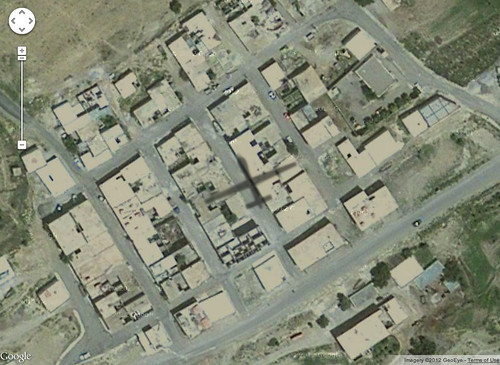
And here I am barely able to keep up with The New Aesthetic.
Meanwhile, TNA honcho James Bridle is cranking out other awesome projects left and right, and works like this one, Shadow, which, yes, please, very much.
Shadow, 2012, via STML’s flickr]
STML, James Bridle’s portfolio site [shorttermmemoryloss.com]
The New Aesthetic [new-aesthetic.tumblr.com]
Delirious Ningbo
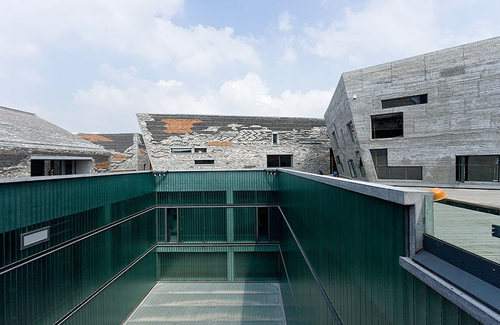
I’ve been busy as all get out, and only now do I realize I haven’t actually posted here for a few days. I blame Twitter.
Anyway, I’m not a real believer in the Pritzker Prize, except when it’s totally awesome, like right now, when they just announced Shanghai-based Wang Shu as the winner of the 2012 architecture award.
Since last night, when LA Times architecture critic Christopher Hawthorne tweeted the news, and promptly began livetweeting Wang’s lecture at UCLA, I’ve been trying to think where it was that I first discovered what’s probably the architect’s most significant work so far, the Ningbo History Museum.
Wang indeed seems like one of the smartest, most sensitive practitioners of architecture in China right now. I say seems, because I really don’t know what’s going on on the ground, below the Western starchitect marquee projects from CCTV to that awful opera house, to that other awful opera house to that Steven Holl Ground Zero-in-Beijing mess, to that one housing development where everyone was brought in to make a Shigeru Ban house on spec? I remember Alvaro Siza telling about designing a building in Guangzhou back in the day, and visiting it as it neared completion, only to find out when he returned for the ribboncutting that the developer client had hurriedly doubled it without telling him.
And then everything else seems like generic futureschlock, and a wholesale disregard for history that’d do the Cultural Revolution proud. And then there was Koolhaas’s presentation on the Pearl River Delta which envisioned all of Hong Kong as basically the future Lower East Side/Astor Place of a massive, 100-mile-wide New York City on the South China Sea.
So that’s my context, with nothing but raw spectacle with a modernist/internationalist veneer.
And then Wang’s Ningbo History Museum, which is surfaced with several million reused bricks, laid in patterns of the laborers’ devising, literally built from the rubble of the past it displaces–and repackages as museum content.
Wang turns out to have trained on construction and renovation teams, giving him an unusual sensitivity to material and process as they express themselves in form and space. I found myself nodding when Hawthorne compared him to Koolhaas, but then I thought, yeah, well, maybe the Koolhaas of Delirious New York, not CCTV and Put Me On The Cover Of Time Magazine. If anything, after this most recent OMA/AMO Venice show about the threat of History, Wang might be the anti-Koolhaas.
Anyway, I’m just rambling here without a plan, only because Wang Shu seems pretty amazing; his projects and proposals bode well, not just for China, but for the world with a modern China in it; and because I want to post one of Iwan Baan’s many illuminating photos of Wang’s built work. This one is the dramatic, hidden interior courtyard of the Ningbo Museum.
And thanks to Brian Sholis, who points to a nice collection of Wang Shu project images and information on the Pritzker Prize’s own media site [pritzkerprize.com]
‘Collectors Are My Power Base’
Abstraction and luxury are the guard dogs of the upper class. – Jeff Koons
— Berfrois (@berfrois) February 20, 2012
It’s well worth looking at the fuller context of that awesome Jeff Koons blurb about abstraction and luxury being the guard dogs of the upper class. [most recently tweeted by @berfrois] It comes from a late 1988 interview with Brooks Adams and Karen Marta, who were then working under the name Burke & Hare, which was published in Parkett 19:
I try to be effective as a leader. I’m very interested in leadership. I think that my own work has been helping to direct a dialogue, and it’s been participating in it for quite some time. I’m anteing up the pressure and trying to increase the stakes continually. I’ve found that collectors are my power base. You know, I’m able to work as a function of thier support of my work. I think that they have to have some interest in debasement and its political possibilities, even for their own use. I mean, it really has to be for their own use. I think that I give them a sense of freedom. I don’t think that I’m debasing them and not leaving them a place to go. I’m creating a whole new area for them once they’re feeling free. I see it as my job to keep the bourgeoisie out of equilibrium letting them form a new aristocracy.
I think it’s necessary that the work be bought, that I have the political power to operate. I enjoy the seduction of the sale. I enjoy the idea that my objectives are being met. I like the idea of the political power base of art, but it’s not just a money thing. It has to be a total coordination of everything, and money is a certain percent of it, maybe 20% of it. Look, abstraction and luxury are the guard dogs of the upper class. The upper class wants people to have ambition and gumption because, if you do, you will participate and you’ll move through society into a different class structure. But eventually, through the tools of abstraction and luxury, they will debase you, and they will get your chips away from you.
1988 was right after his Banality show, the Complete Spot Paintings of its day, which opened, outrageously, in three galleries at once in New York [Sonnabend], Berlin [Max Hetzler], and Chicago [Donald Young]. But it was before Made In Heaven, it was before he basically went bankrupt–and nearly took Deitch with him–making his balloon dogs and whatnot. It was a Koonsianism several orders of magnitude less intense that the Koonsianism we see today.
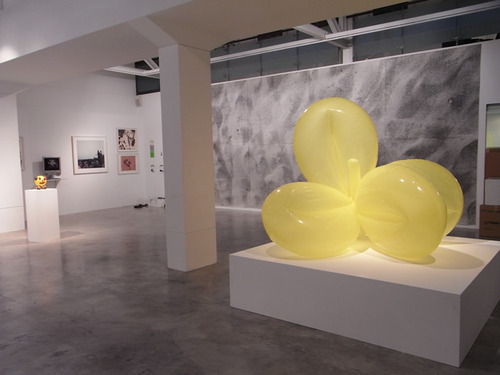
Jeff and Felix sittin’ in a tree. P-A-R-K-E-T-T
His political interpretation also resonates with Felix Gonzalez-Torres’ discussion from 1994:
At this point I do not want to be outside the structure of power, I do not want to be the opposition, the alternative. Alternative to what? To power? No. I want to have power. It’s effective in terms of change. I want to be like a virus that belongs to the institution. All the ideological apparatuses are, in other words, replicating themselves, because that’s the way the culture works.
Max Ernst Staring Contest
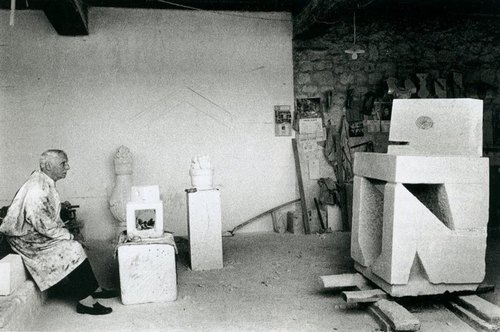
Of the many extraordinary photos of Max Ernst and his sculptures that Michael posted at stopping off place this week, this is my hands-down favorite
My guess is Thomas Houseago has stared long and hard at this thing as well.
image from Max Ernst: sculptures, maisons, paysages at Ecole des tueurs [stoppingoffplace]
The Grid-Sphere Satellite And The Doomsday Stone
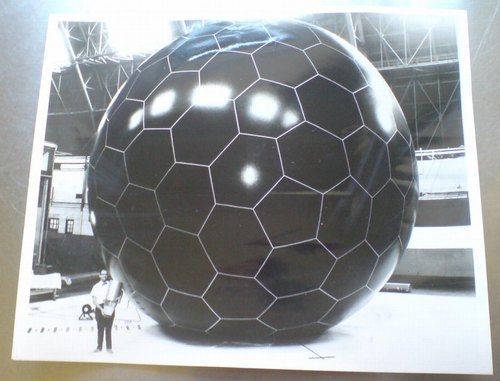
Last year I picked up this extraordinary photograph, and then didn’t have immediate results researching it, so I put it away until now. Then, wow.
NASA launched the first Project Echo communications satelloon in 1960 to much fanfare, but the 100-foot diameter inflated Mylar sphere’s actual performance as a reflective signal relay fell short of predictions. Echo IA launched in 1960 and stayed aloft and visible from earth until 1966, but it partially deflated within a few weeks, which weakened its reflectivity. And the drag of such a large object decayed its orbital speed in ways that made it an unreliable relay.
Soon after Echo II’s launch in 1964 by NASA and Bell Labs, the US Air Force began pursuing a next-generation technology with one of its leading military contractors, Goodyear Aerospace: the grid sphere.
The grid sphere satellite was designed, near as I can tell, by Goodyear Aerospace engineer Howard Barrett. The 30-food diameter sphere of rigidized, laminated aluminum wire was embedded in a UV-sensitive plastic, which would photolyze, or disintegrate, after inflating in space, leaving the open grid sphere intact. The sphere was calculated to produce a backscatter reflection signal more than 5x as powerful as the Mylar solid sphere three times its diameter, and would be immune to its puncture, deflation, and solar radiation drag effects.

image via National Museum of the US Air Force
I’ve found mention of both 2-foot and 14-foot diameter grid sphere models, and another image of this 30-foot test inflation. Good gravy, did they really just inflate it using that tiny, leaf blower thing? I think it goes without saying, but I’ll say it anyway, that when it launched in 1966 from Vandenburg AFB on an Atlas rocket, the grid sphere satellite became the second-most beautiful object ever put into space. Between July 13, 1966 and May 24, 1968, when Echo IA burned up in the atmosphere, there were two satelloons and this open grid sphere, all orbiting the earth together, in Minimalism’s awesomest group show.
Which would be cool enough on its own. And then Andy Beach sends me this.
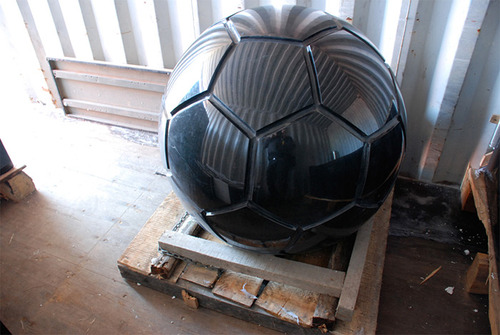
It’s Nicholas Mangan’s 2008 photo of Ed Grothus’s Doomsday Stone. Grothus was the atomic technician-turned-anti-nuclear peace activist-and-retail-icon who ran The Black Hole, the legendary military/scientific surplus store in Los Alamos, New Mexico. Grothus died in 2009 without being able to realize his decades-in-the-making Doomsday Stones memorial, a set of massive black granite obelisks carved with warnings in 15 languages about the destructive power of nuclear weapons.
The obelisks I’d heard about, but not this insanely awesome 1-meter, 1.5-ton, black granite sphere, which rests alongside them in a shipping container in Grothus’s backyard. Mangan:
In late 2007 Ed went to the Art in Public Places board in Los Alamos to offer them his monuments for public display. They rejected them stating that ‘they couldn’t think of anywhere in Los Alamos where they would fit in’. They backed up their rejection by claiming that Ed was not an ‘Artist’ according to their set of definitions and requirements.
There is something about a prophet in his own country here. Grothus’s Doomsday Stones are art in every sense of the word, and his work is an artistic practice of the highest kind, and should be recognized as such.
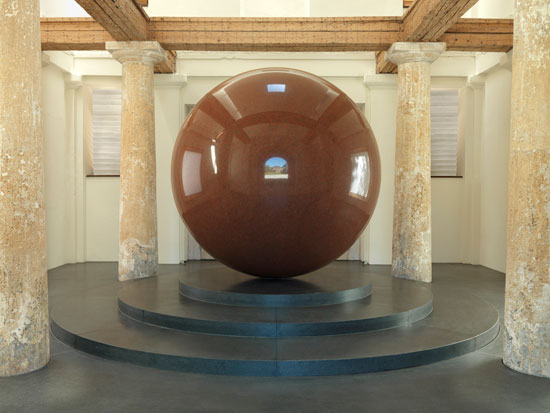
Large Red Sphere, Walter de Maria, 2010, permanent installation at Kunstareal, Munich, image: e-flux
The self-proclaimed art world ignores Grothus at the peril of its own credibility and relevance. If it’s just a matter of the research not being done, let’s get on it. If we need to inflate the critical balloon to give Grothus’s reputation the structure it is obviously meant to have, let’s start blowing. From his quixotic minimalist megalomania in the desert [Heizer, Turrell, De Maria] to his performative taunts in high Catholic regalia [Klein], to his fantastical historical dumpsterdiving [Dion], Grothus is Los Alamos’ own Simon Rodia. It’s just a question of how long it’ll take everyone to realize it.
Make No Small Plans: Autoprogettazione 2.0
Look, I don’t care if you ARE Domus and you have Paola Antonelli herself as a judge; it is no small thing to call your design competition Autoprogettazione 2.0:
Autoprogettazione 2.0 is an invitation to consider the potential of a diffused, localised manufacturing network combined with the self-build ethos proposed by Mari for the future of furniture design. It is an open-ended process that seeks to leverage the combined intelligence and talent of the design community and collaborative, open-source networks. Selected projects will be exhibited by Domus in an exhibition exploring the future of manufacturing hosted in Palazzo Clerici, one of Milan’s most prestigious palazzi.
The submission deadline is 27 March 2012.
The categories are table, chair, lamp, and storage, and the designs will be judged in part by how awesomely they exploit the fancy CNC and 3-D printing setups in the FabLab.
Frankly, it sounds interesting and on the up and up, but all a bit out of my league. And anyway, I don’t quite get how these new, cutting edge technologies are really the optimum solution for the space’s adaptable, quick & dirty, utilitarian, functional program. Not to be a curmudgeon about it, but my gimmicky meter is redlining right now.
Call for ideas: Autoprogettazione 2.0 [domusweb.it via, uhm, I forget. remind me?]
4/14 UPDATE And we have some winners. Nice stuff. You quiero El Gringo. For all the fab FabLab capabilities, it looks like plywood is still the go-to material for knock-together utilitarian furniture. [via @cityofsound]
